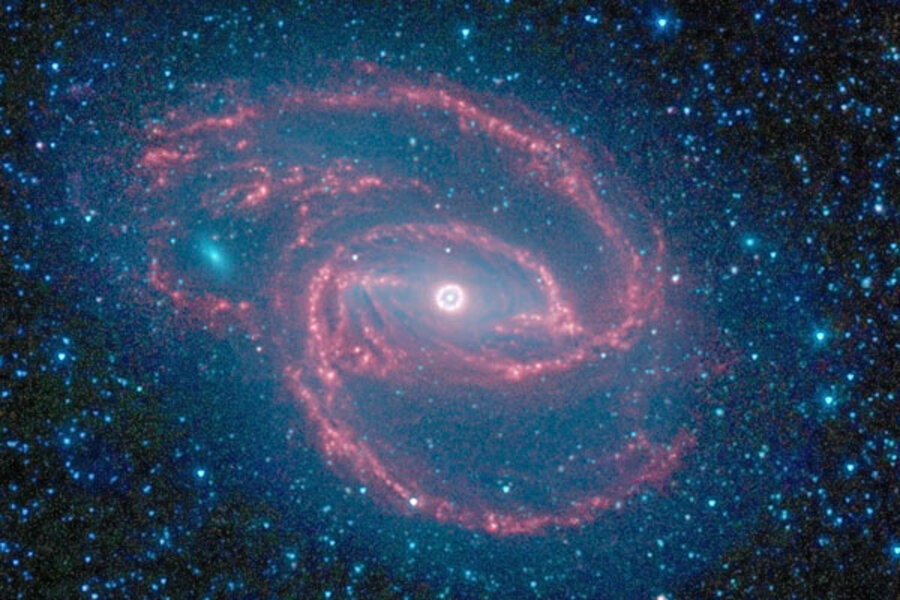Giant black holes a window into origins of earliest galaxies
Loading...
Astronomers have discerned evidence for supermassive black holes at the hearts of some of the earliest galaxies detected to date – budding when the universe was between 700 million and 950 million years old.
The detection, announced Wednesday and appearing in Thursday's issue of the journal Nature, already is hinting at answers to longstanding riddles surrounding the origin of supermassive black holes, which lurk in the cores of all galaxies.
The observations also are helping to tease out the role these black holes in galactic centers might have played in lighting up the universe following an early period known as the "dark ages."
The results mark "the first time we've caught black holes in the act of vigorously growing in the early universe," along with their host galaxies, says Mitchell Begelman, an astrophysicist at the University of Colorado at Boulder.
For theorists interested in black holes and their role in the evolution of galaxies, the detection represents a watershed.
The ability to spot galactic black holes within the first billion years of the universe's existence "isn't a baby step forward," says Priya Natarajan, a Yale University cosmologist and member of the team reporting the results. It presages "a really large leap in our understanding" of how the first supermassive black holes formed.
Black holes are cosmic objects so massive that not even light can escape their gravitational tug.
So-called stellar black holes form when stars at more than 20 times the sun's mass collapse and explode at the end of their lives.
But black holes also lurk at the center of galaxies. These range from several hundred thousand to billions of times the sun's mass.
As astrophysicists have studied these supermassive black holes and the galaxies they inhabit, they have noticed that the bigger the galaxy, the more massive the black hole at the galaxy's core.
Indeed, these objects are thought to play key roles in controlling the growth of galaxies themselves, which in turn feeds back on the evolution of their supermassive black holes.
The puzzle: How do these central black holes originate?
"It's pretty clear that you first make small 'seed' black holes in the early universe, and over cosmic time, by swallowing gas in their vicinity, they grow," says Dr. Natarajan, "But how you form seed black holes is an open-ended question."
Do they form from the large numbers of stellar black holes that would have formed in large numbers from the first stars? Or do the seed black holes form directly from the direct collapse of a massive gas cloud, with no intermediate steps of star formation and death?
To tackle the question, someone first must spot some sort of evidence for galactic galactic black holes in the very early universe.
The team, led by Ezequiel Treister, a researcher at the University of Hawaii's Institute for Astronomy, used the Chandra X-Ray Observatory to look at the collective X-ray emissions from some 197 youthful galaxies imaged by the Hubble Space Telescope.
Although light can't escape from a black hole itself, the mass of dust and gas swirling inward toward its brink collides at ever higher energies, generating X-rays. These X-rays can penetrate the thick shrouds of dust and gas that permeate these early galaxies and mask them from view in visible or ultraviolet light.
The team wasn't able to spot individual black holes per se. But they were able to gather enough X-ray information to confidently claim detection when the location of the exceedingly faint emissions of the X-rays were correlated with galaxies from the Hubble survey.
Out of data the team analyzed involving some 200 galaxies, the researchers estimate that from 30 to 100 percent of these galaxies host supermassive black holes.
That implies that as many as 30 million supermassive black holes permeated the early universe – some 10,000 times more than indicated in previous studies based on somewhat older, enormously energetic galactic black holes, dubbed quasars.
The presence of well-developed supermassive black holes within the first 1 billion years of the universe's existence argues for the cloud-collapse explanation, Dr. Natarajan says.
It implies that the galaxies and their supermassive black holes were co-evolving in ways that wouldn't have happened if the seeds were generated through the mergers of individual stellar black holes.





